Key takeaways:
- Therapy fosters self-awareness and emotional clarity, transforming decision-making and emotional burdens into manageable experiences.
- Choosing the right therapist and setting realistic goals are crucial for maximizing therapeutic benefits and ensuring a supportive environment.
- Incorporating techniques like mindfulness, journaling, and self-reflection into daily life enhances therapy outcomes and reinforces personal growth.
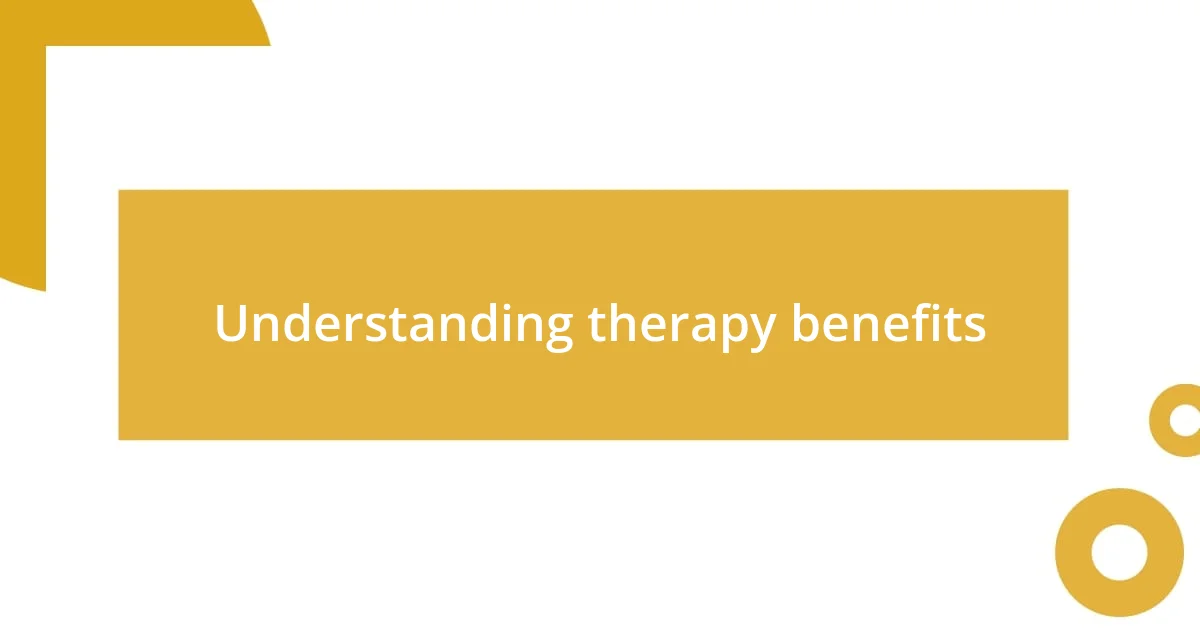
Understanding therapy benefits
Therapy benefits can sometimes feel like an elusive treasure, but I’ve found that they often reveal themselves slowly. For instance, in my own journey, I noticed that regular sessions helped me develop a deeper sense of self-awareness. I remember leaving one session feeling lighter—like a fog had lifted—and it dawned on me that understanding my emotions was a fundamental shift.
Many might wonder if the investment in therapy truly pays off. From my experience, the answer is a resounding yes. There was a moment when I faced a particularly tough decision; discussing it in therapy allowed me to unpack my fears and values. This clarity transformed not just my decision-making process but how I viewed challenges in general.
Another powerful benefit I’ve experienced is the sense of connection therapy brings. It can sometimes feel isolating to carry emotional burdens, but having a space to express my feelings without judgment made all the difference. How about you? Have you ever felt that relief when you finally unburdened yourself? That moment of release is what makes therapy transformative; suddenly, I wasn’t alone in my thoughts anymore.
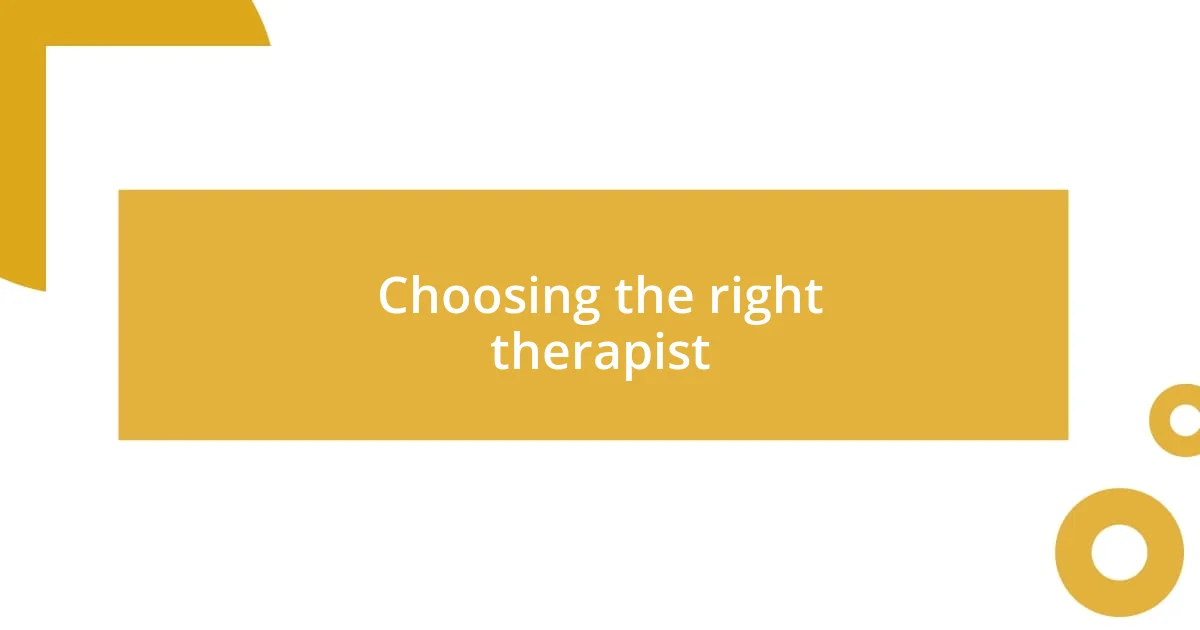
Choosing the right therapist
Choosing the right therapist is a crucial step in making the most of your therapy experience. I vividly recall my initial search for a therapist; it felt almost overwhelming. I remember meeting a few who, while skilled, didn’t quite resonate with me. Finding someone who understands your unique perspective and fosters a genuine connection can truly amplify the benefits of therapy.
When considering a therapist, I find it helpful to ask myself a few key questions:
- What are their credentials and areas of expertise?
- Do I feel comfortable sharing personal details with them?
- Have they successfully worked with clients who have similar issues to mine?
- What therapeutic approaches do they utilize, and do those align with my preferences?
- Can I sense a vibe of trust and safety in our initial meeting?
Reflecting on these points can make the process feel more intentional and ensure that the therapeutic relationship is one that supports growth and healing.
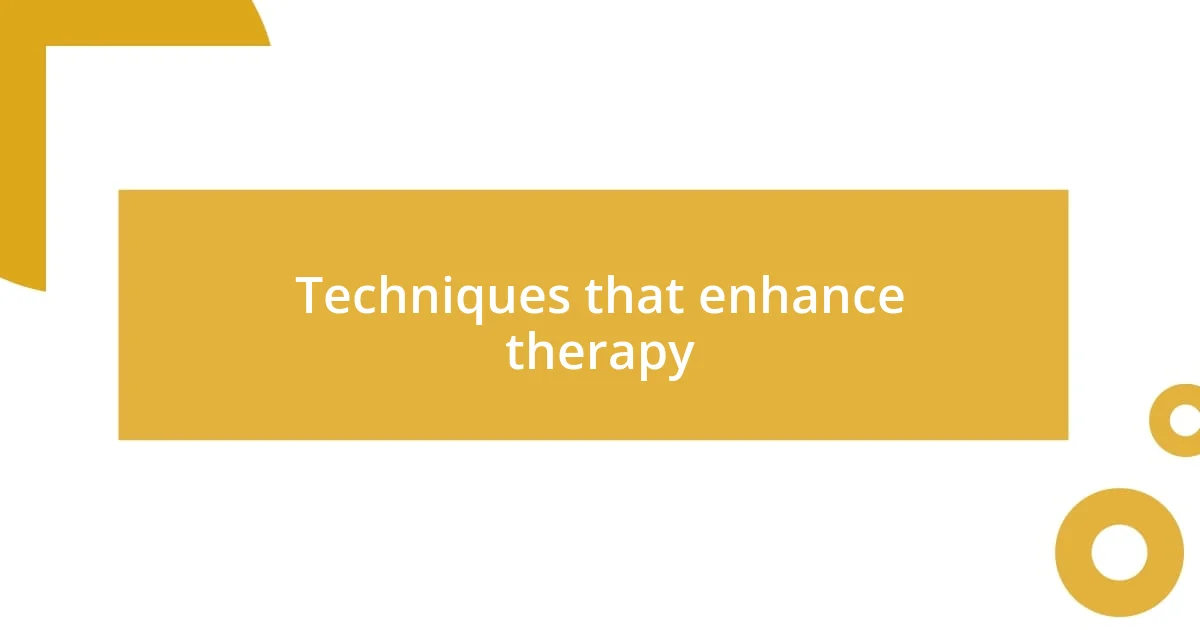
Techniques that enhance therapy
The techniques that enhance therapy can vary greatly, but I’ve discovered a few that genuinely clarify and deepen the therapeutic experience. One such technique is mindfulness. During my sessions, I sometimes engage in mindfulness exercises, such as simple breathing techniques. I remember a particular instance when focusing on my breath transformed my anxiety into calmness, allowing me to delve deeper into my feelings without getting overwhelmed.
Another effective technique I’ve encountered is journaling. Before or after therapy, I often jot down my thoughts and emotions. Reflecting on these notes not only helps me remember key insights from my sessions but also allows me to process feelings in a structured way. There was a time when I was surprised to discover themes in my writing that I hadn’t consciously recognized during our discussions.
Art therapy is also worth mentioning—a creative outlet that has added depth to my healing journey. I recall the first time I painted in session; it felt liberating to express emotions that words failed to capture. This technique not only made the experience enjoyable but also led to profound revelations about my inner self.
| Technique | Description |
|---|---|
| Mindfulness | Helps create awareness by focusing on the present moment, reducing anxiety |
| Journaling | Encourages reflection on thoughts and emotions, allowing for deeper understanding |
| Art Therapy | Utilizes creative expression to articulate feelings and explore subconscious thoughts |
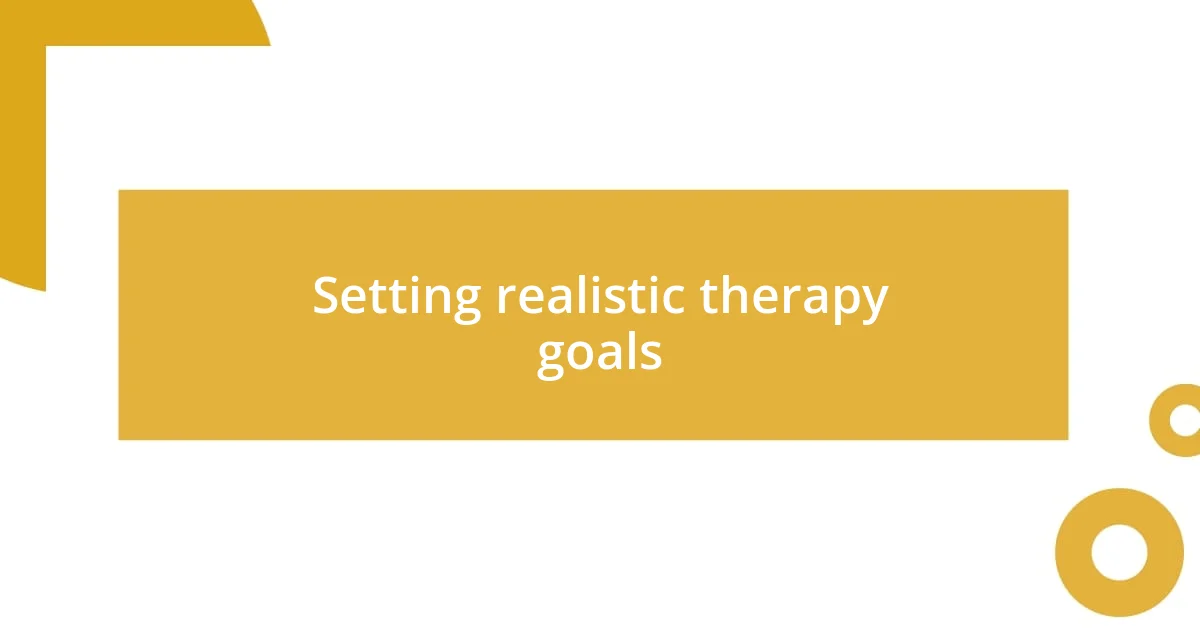
Setting realistic therapy goals
Setting realistic therapy goals is pivotal in ensuring a productive therapeutic journey. I learned this firsthand during my early days in therapy when I approached it with lofty expectations. I thought I would uncover all the answers to my struggles in just a few sessions. But as I reflected more, I realized that meaningful change takes time and patience.
During one of my sessions, my therapist challenged me to set a specific goal: to address one particular issue at a time instead of overwhelming myself with everything at once. I remember that moment distinctly because it felt liberating. By breaking things down into manageable pieces, I not only made progress but also experienced smaller victories that fueled my motivation along the way.
Have you ever felt your goals drifting beyond what feels achievable? I know I have. It’s important to continuously assess these goals with your therapist. Together, we would often revisit, adjust, and celebrate achievements, no matter how small. This practice not only kept me grounded but also reminded me that therapy is a process, and it’s okay to take it one step at a time.
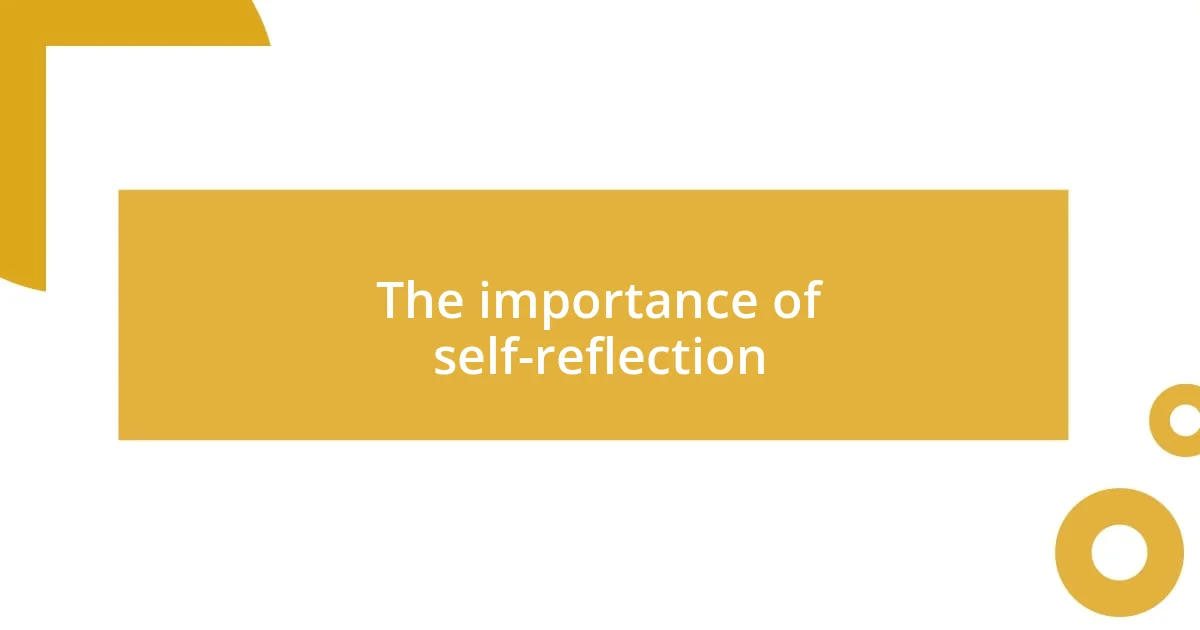
The importance of self-reflection
Self-reflection plays a crucial role in therapy, as it allows us to gain insight into our thoughts and behaviors. I’ve found that taking time to reflect, especially after sessions, helps me identify patterns I might otherwise overlook. Have you ever noticed how certain themes crop up repeatedly in your thoughts? Recognizing these themes has been vital in my healing journey.
One impactful moment for me came after a particularly emotional session. I sat alone with my thoughts and asked myself what emotions I felt and why. This practice of self-inquiry unveiled layers of understanding about unresolved issues from my past. It’s fascinating how taking just a few moments to sit in silence can open avenues to deeper self-awareness.
In my experience, self-reflection not only fosters understanding but also encourages accountability. By regularly evaluating my progress and feelings, I hold myself responsible for the changes I wish to see. I often think, “What steps can I take to align my actions with my goals?” This approach not only clarifies my intentions but reinvigorates my commitment to personal growth.
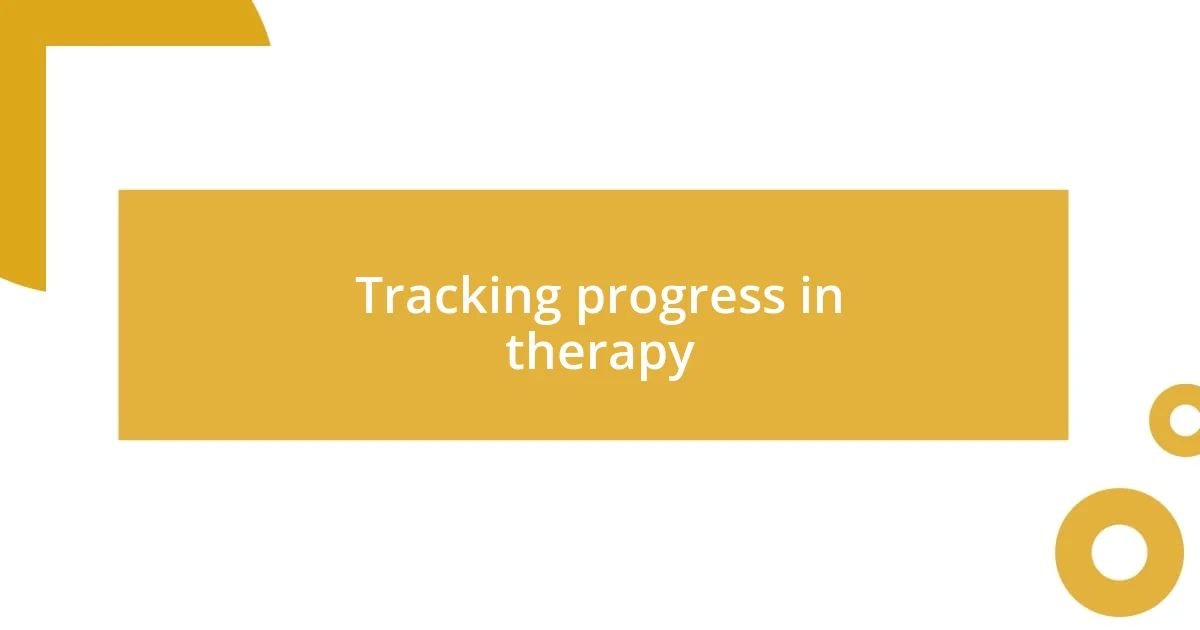
Tracking progress in therapy
Tracking progress in therapy can feel like piecing together a complex puzzle. I remember journaling my feelings after sessions, which allowed me to see my growth over time. It was rewarding to look back and recognize how my thoughts shifted or how certain triggers had less impact on me than before. Have you ever experienced the power of journaling? The words on the page became a tangible record of my journey, illuminating the milestones I may have otherwise overlooked.
There’s also something incredibly motivating about visual reminders of progress, like using a simple chart or app to log my achievements. Initially, I was skeptical about the effectiveness of tracking in this way, but once I embraced it, I found it genuinely exciting. Each small tick for progress was a tiny celebration—a reminder that change is happening, even when it feels slow. How might you celebrate your progress?
In our sessions, my therapist often helped me reflect on these tracking tools. I learned that discussing my findings each week transformed raw data into meaningful conversations about my emotions and experiences. This dialogue not only validated my efforts but also helped refine my goals even further. Looking back, I see how integrating progress tracking into my therapy wasn’t just about noting changes; it became a catalyst for deeper understanding and healing.
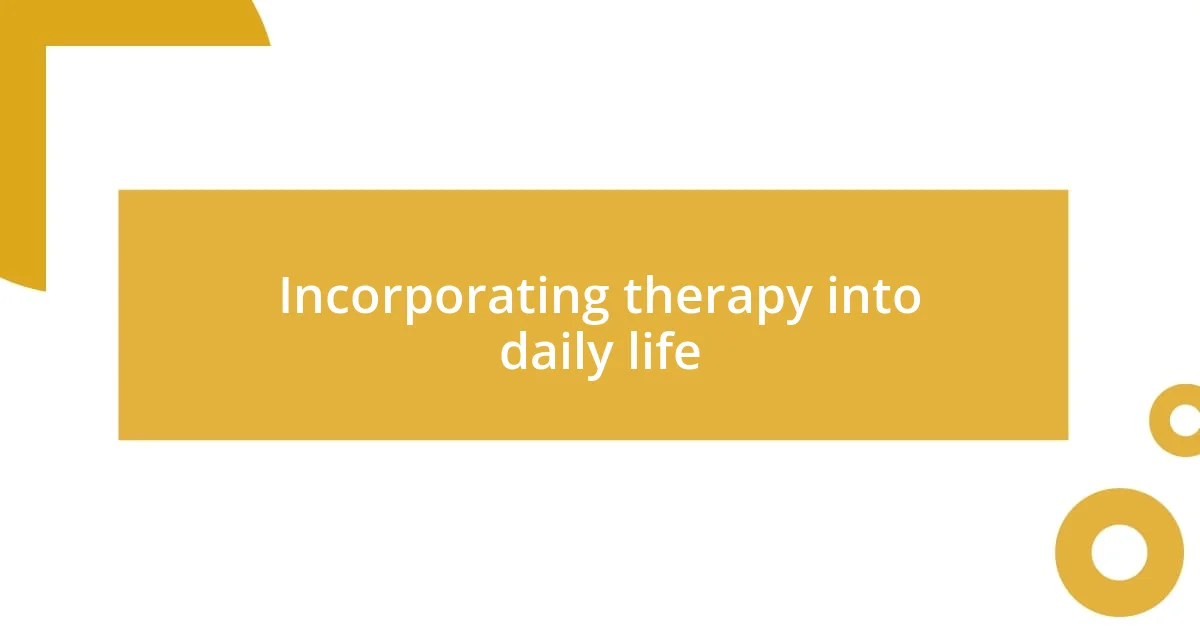
Incorporating therapy into daily life
One way I’ve found to incorporate therapy into daily life is by turning therapeutic insights into actionable steps. For instance, after discussing anxiety triggers in a session, I created a mini self-care routine that includes deep breathing and a few moments of gratitude each day. It’s almost funny how a quick pause to acknowledge what I’m thankful for can shift my mood—have you ever tried something similar?
I also started to dedicate specific moments in my day for reflection, often during my morning coffee or evening wind-down. I’ll sit with my thoughts and consider how the events of the day tie back to what I’ve been learning in therapy. Just the other night, I found myself thinking about a stressful encounter and realized I handled it completely differently than I would have in the past. This simple practice connects me to my therapy work and reinforces the changes I’m striving to implement. How do you reinforce your therapy lessons in your routine?
Incorporating affirmations into my daily schedule has been a game changer too. I began repeating phrases such as “I am on the path to healing” during my commute, and it felt empowering. At first, it seemed a bit awkward, but over time, those words molded my mindset. When I notice my thoughts drifting to negativity, I remind myself of those affirmations to guide me back to a healthier perspective. Have you considered the power of positive affirmations in your own life?















